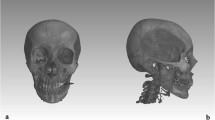Abstract
Sex determination on skeletal remains is one of the most important diagnosis in forensic cases and in demographic studies on ancient populations. Our purpose is to realize an automatic operator-independent method to determine the sex from the bone shape and to test an intelligent, automatic pattern recognition system in an anthropological domain. Our multiple-classifier system is based exclusively on the morphological variants of a curve that represents the sagittal profile of the calvarium, modeled via artificial neural networks, and yields an accuracy higher than 80 %. The application of this system to other bone profiles is expected to further improve the sensibility of the methodology.


Similar content being viewed by others
Notes
From now on, we use the terms “sample” and “sub-sample” according to their statistical meaning, i.e., random data samples drawn from a population. The specific quantity they refer to (e.g., pixels, signature functions, ...) is made clear by the context.
According to the topology of the graph defined by the specific connections.
BP is an MLP-tailored instance of the gradient method for online non-linear optimization. Any MLP software simulator is expected to provide the user with BP (or one of its many variants).
Provided that P(ω 0∣x j ) is continuous and limited.
References
Acsádi G, Nemeskéri J (1970) History of human life span and mortality. Akadémiai Kiadó
Bishop CM (1995) Neural networks for pattern recognition. Oxford University Press
Canny J (1986) A computational approach to edge detection. IEEE Trans Pattern Anal Mach Intell 8:679–698
Chidiac JJ, Shofer FS, Al-Kutoubi A, Laster LL, Ghafari J (2002) Comparison of CT scanograms and cephalometric radiographs in craniofacial imaging. Orthod Craniofac Res 5:104–113
Davies ER (2004) Machine vision: theory, algorithms, practicalities. Elsevier
Duda RO, Hart PE (1973) Pattern classification and scene analysis. Wiley, New York
Efron B, Tibshirani RJ (1993) An introduction to the bootstrap. Chapman & Hall, New York
Gybenko G (1989) Approximation by superposition of sigmoidal functions. Math Control Signals Syst 2:303–314
Hsiao TH, Chang HP, Liu KM (1996) Sex determination by discriminant function analysis of lateral radiographic cephalometry. J Forensic Sci 41:792–795
Hsiao T-H, Tsai S-M, Chou S-T, Pan J-Y, Tseng Y-C, Chang H-P, Chen H-S (2010) Sex determination using discriminant function analysis in children and adolescents: a lateral cephalometric study. Int J Legal Med 124:155–160
Inoue M (1990) Fourier analysis of the forehead shape of skull and sex determination by use of computer. Forensic Sci Int 47:101–112
Lee FCC, Noar JH, Evans RD (2011) Evaluation of the CT scanogram for assessment of craniofacial morphology. Angle Orthod 81:17–25
Luo L, Wang M, Tian Y, Duan F, Wu Z, Zhou M, Rozenholc Y (2013) Automatic sex determination of skulls based on a statistical shape model. Comput Math Methods Med 2013:251628:1–251628:6
Nakhaeizadeh S, Dror IE, Morgan RM (2014) Cognitive bias in forensic anthropology: visual assessment of skeletal remains is susceptible to confirmation bias. Sci Justice 54:208– 214
Novotny V, Iscan MY, Loth SR (1993) Morphologic and osteometric assessment of age, sex, and race from the skull. Forensic Analysis of the Skull:71–88
Ogawa Y, Imaizumi K, Miyasaka S, Yoshino M (2013) Discriminant functions for sex estimation of modern Japanese skulls. J Forensic Legal Med 20:234–238
Ramsthaler F, Kettner M, Gehl A, Verhoff MA (2010) Digital forensic osteology: morphological sexing of skeletal remains using volume-rendered cranial CT scans. Forensic Sci Int 195:148–152
Richard MD, Lippmann RP (1991) Neural network classifiers estimate Bayesian a posteriori probabilities. Neural Comput 3:461–483
Rogers TL (2005) Determining the sex of human remains through cranial morphology. J Forensic Sci 50:493–500
Rösing FW, Graw M, Marré B, Ritz-Timme S, Rothschild MA, Rötzscher K, Schmeling A, Schroder I, Geserick G (2007) Recommendations for the forensic diagnosis of sex and age from skeletons. HOMO-Journal of Comparative Human Biology 58:75–89
Spradley MK, Jantz RL (2011) Sex estimation in forensic anthropology: skull versus postcranial elements. J Forensic Sci 56:289–296
Trentin E (2006) Simple and effective connectionist nonparametric estimation of probability density functions. ANNPR (Artificial Neural Networks in Pattern Recognition):1–10
Van Otterloo PJ (1991) A contour-oriented approach to shape analysis. Prentice Hall International Ltd., UK
Veyre-Goulet SA, Mercier C, Robin O, Guerin C (2008) Recent human sexual dimorphism study using cephalometric plots on lateral teleradiography and discriminant function analysis. J Forensic Sci 53:786–789
Walrath DE, Turner P, Bruzek J (2004) Reliability test of the visual assessment of cranial traits for sex determination. Am J Phys Anthropol 125:132–137
Zhang D, Lu G (2001) A comparative study on shape retrieval using Fourier descriptors with different shape signatures. In: Proceedings of the international conference on intelligent multimedia and distance education (ICIMADE01)
Doi K (2005) Current status and future potential of computer-aided diagnosis in medical imaging. Br J Radiol 78:s3–s19
Author information
Authors and Affiliations
Corresponding author
Ethics declarations
Conflict of interests
The authors declare that they have no conflict of interest.
Appendix: The algorithm for probability density estimation
Appendix: The algorithm for probability density estimation
Let x 1, …,x n be a collection of n CT-scans, thought of as d-dimensional random vectors and assumed to be independently and identically drawn from an unknown pdf p(.). Also, let φ(.) be a proper kernel function (e.g., a standard Gaussian), and let the corresponding bandwidth h 1 be any positive real number (to be fixed empirically) [2]. An unbiased estimate \({\tilde p}(.)\) of p(.) via MLP is proposed, according to the following unsupervised algorithm (expressed in pseudo-code):

where \(\frac {1}{n-1} {\sum }_{\textbf {x} \in \mathcal {T}_{i}} \frac {1}{V_{n-1}} \varphi \left (\frac {\textbf {x}_{i} - \textbf {x}}{h_{n-1}}\right )\) is the Parzen kernel expansion of p(.) over the n−1 feature vectors in \(\mathcal {T}_{i}\), V n−1 being the corresponding volume of the window function [6].
Rights and permissions
About this article
Cite this article
Cavalli, F., Lusnig, L. & Trentin, E. Use of pattern recognition and neural networks for non-metric sex diagnosis from lateral shape of calvarium: an innovative model for computer-aided diagnosis in forensic and physical anthropology. Int J Legal Med 131, 823–833 (2017). https://doi.org/10.1007/s00414-016-1439-8
Received:
Accepted:
Published:
Issue Date:
DOI: https://doi.org/10.1007/s00414-016-1439-8




